WinSLAMM Simulation of Hydrologic Performance of Permeable Pavements—A Case Study in the Semi-Arid Lower Rio Grande Valley of South Texas, United States
Abstract
1. Introduction
2. Methods
- City of Brownsville (COB)—porous concrete pavement (PCP)
- City of La Feria (COLF)—permeable interlocking concrete pavement (PICP)
- Cameron County Drainage District #1 Cascade Park (CCDD#1)—interlocking block pavement with gravel (IBPG).
2.1. Field and Laboratory Data Preparation
2.2. Model Development
2.3. Initial Model Simulation
2.4. Model Calibration and Validation
- (i)
- The overlapping of the model-simulated runoff reduction-rainfall trend line with the observed runoff reduction trend line appears optimal.
- (ii)
- A higher or acceptable value of (R2 > 0.8) and NSE (close to 1) corresponded with a perfect match of model-simulated results to the observed data. However, this criterion may vary depending upon the quality of the observed data [53].
- (iii)
- A lower RMSE (<30%) resulted in model-simulated outcomes [54].
- (iv)
- A p-value less than 0.05 or within a 95% confidence interval boundary better supports the regression correlation between observed and model-predicted results [55].
3. Results and Discussion
3.1. Model Calibration and Validation Results
3.2. WinSLAMM Application in Hydrologic Performance Assessment
3.2.1. Runoff Reduction over Varying Rainfall Depths
3.2.2. Peak Discharge over Varying Impervious Drainage Areas and Pavement Installation Sizes
3.2.3. Runoff Reduction with Varying Sensitive Design Parameters
4. Conclusions
- The model calibration equations (correlating simulated runoff reduction and rainfall depth) appear to be helpful in predicting surface runoff reduction from permeable pavements over a wide range of rainfall events.
- The model calibration runs suggested that PCP and IBPG designs might be capable of handling rainfall events as large as a 50-year frequency event over a 24-h time period in the semi-arid climatic region of the LRGV, depending on the pavement designs and field conditions. However, the PCP installation showed the optimal runoff reduction when compared to the other monitored types of pavements.
- The PCP performance was also evaluated over a broad range for different sizes of commercial developments in the LRGV region. The model-simulated results suggested that it should require a comparatively smaller PCP footprint within a commercial development than other types to achieve the same amount of discharge goal.
- The existing PCP design was highly sensitive to its base aggregate porosity. Higher storage of infiltrated runoff could be achieved if conventional angular aggregates were replaced with crushed stone or similar #4 aggregates with higher porosity during PCP construction.
Supplementary Materials
Author Contributions
Funding
Acknowledgments
Conflicts of Interest
References
- Kannan, N.; Jeong, J.; Srinivasan, R. Hydrologic Modeling of a Canal-Irrigated Agricultural Watershed with Irrigation Best Management Practices: Case Study. J. Hydrol. Eng. 2011, 16, 746–757. [Google Scholar] [CrossRef]
- Kannan, N. SWAT Modeling of the Arroyo Colorado Watershed; Texas Water Resources Institute: College Station, TX, USA, 2012. [Google Scholar]
- Hernandez, E.A.; Uddameri, V. An assessment of optimal waste load allocation and assimilation characteristics in the Arroyo Colorado River watershed, TX along the US–Mexico border. Clean Technol. Environ. Policy 2013, 15, 617–631. [Google Scholar] [CrossRef]
- Raines, T.H.; Miranda, R.M. Simulation of Flow and Water Quality of the Arroyo Colorado, Texas; USGS: Austin, TX, USA, 2002.
- A.C.W.P. A Watershed Protection Plan for the Arroyo Colorado—Phase I; A Report of the Arroyo Colorado Watershed Partnership and Texas Sea Grant; 2007; pp. 31–59. [Google Scholar]
- Flores, J.; Benavides, J.A.; Cawthon, T. Update to the Arroyo Colorado Watershed Protection Plan; Texas Water Resources Institute: College Station, TX, USA, 2017. [Google Scholar]
- USEPA. Stormwater Technology Fact Sheet-Wet Detention Ponds. Available online: https://nepis.epa.gov/Exe/ZyPDF.cgi/200044D0.PDF?Dockey=200044D0.PDF (accessed on 18 September 2018).
- Hunt, W.F. Working with Regulators to Change Permeable Pavements Acceptance. In Proceedings of the American Society of Civil Engineers Low Impact Development, Buenos Aires, Argentina, 11–14 April 2010; pp. 1270–1280. [Google Scholar]
- Drake, J.A.P.; Bradford, A.; Marsalek, J. Review of environmental performance of permeable pavement systems: State of the knowledge. Water Qual. Res. J. 2013, 48, 203–222. [Google Scholar] [CrossRef]
- Pratt, C.J.; Mantle, J.D.G.; Schofield, P.A. UK research into the performance of permeable pavement, reservoir structures in controlling stormwater discharge quantity and quality. Water Sci. Technol. 1995, 32, 63–69. [Google Scholar] [CrossRef]
- Collins, K.A.; Hunt, W.F.; Hathaway, J.M. Hydrologic Comparison of Four Types of Permeable Pavement and Standard Asphalt in Eastern North Carolina. J. Hydrol. Eng. 2008, 13, 1146–1157. [Google Scholar] [CrossRef]
- Huang, J.; Valeo, C.; He, J.; Chu, A. Three Types of Permeable Pavements in Cold Climates: Hydraulic and Environmental Performance. J. Environ. Eng. 2016, 142, 04016025. [Google Scholar] [CrossRef]
- Barbosa, A.E.; Fernandes, J.N.; David, L.M. Key issues for sustainable urban stormwater management. Spec. Issue Stormwater Urban Areas 2012, 46, 6787–6798. [Google Scholar] [CrossRef] [PubMed]
- Church, P.E.; Granato, G.E.; Owens, D.W. Basic Requirements for Collecting, Documenting, and Reporting Precipitation and Stormwater-Flow Measurements; USDOT; USGS: Austin, TX, USA, 2003; pp. 47–49.
- Chow, M.F.; Yusop, Z.; Mohamed, M. Quality and first flush analysis of stormwater runoff from a tropical commercial catchment. Water Sci. Technol. 2011, 63, 1211–1216. [Google Scholar] [CrossRef]
- Brezonik, P.L.; Stadelmann, T.H. Analysis and predictive models of stormwater runoff volumes, loads, and pollutant concentrations from watersheds in the Twin Cities metropolitan area, Minnesota, USA. Water Res. 2002, 36, 1743–1757. [Google Scholar] [CrossRef]
- Dietz, M.E. Low Impact Development Practices: A Review of Current Research and Recommendations for Future Directions. Water. Air Soil Pollut. 2007, 186, 351–363. [Google Scholar] [CrossRef]
- Scholz, M.; Grabowiecki, P. Review of permeable pavement systems. Build. Environ. 2007, 42, 3830–3836. [Google Scholar] [CrossRef]
- Lucke, T.; Beecham, S. Field investigation of clogging in a permeable pavement system. Build. Res. Inf. 2011, 39, 603–615. [Google Scholar] [CrossRef]
- Jayasooriya, V.M.; Ng, A.W.M. Tools for Modeling of Stormwater Management and Economics of Green Infrastructure Practices: A Review. Water. Air Soil Pollut. 2014, 225, 2055. [Google Scholar] [CrossRef]
- Brattebo, B.O.; Booth, D.B. Long-term stormwater quantity and quality performance of permeable pavement systems. Water Res. 2003, 37, 4369–4376. [Google Scholar] [CrossRef]
- Bean, E.Z.; Hunt, W.F.; Bidelspach, D.A. Evaluation of Four Permeable Pavement Sites in Eastern North Carolina for Runoff Reduction and Water Quality Impacts. J. Irrig. Drain. Eng. 2007, 133, 583–592. [Google Scholar] [CrossRef]
- NOAA. National Weather Service Forecast Office, Brownsville, TX. Available online: https://w2.weather.gov/climate/xmacis.php?wfo=bro (accessed on 29 August 2018).
- Zhang, S.; Guo, Y. SWMM Simulation of the Storm Water Volume Control Performance of Permeable Pavement Systems. J. Hydrol. Eng. 2014, 20, 06014010. [Google Scholar] [CrossRef]
- Hamid, R.; Tsihrintzis, V.A.; Fuentes, H.R. Model Validation for Runoff Pollution from Urban Watersheds; ASCE: Reston, VA, USA, 1995; pp. 141–144. [Google Scholar]
- Kipkie, C.W.; James, W. Feasibility of a permeable pavement option in SWMM for long-term continuous modeling. Appl. Model. Urban Water Syst. 2000, 8, 303–324. [Google Scholar] [CrossRef]
- James, W.R.C.; James, W.; Langsdorff, H.V. Stormwater management model for environmental design of permeable pavement. Models Appl. Urban Water Syst. 2001, 9, 423. [Google Scholar] [CrossRef]
- Schlüter, W.; Jefferies, C. Modelling the outflow from a porous pavement. Urban Water 2002, 4, 245–253. [Google Scholar] [CrossRef]
- Hohaia, N.; Fassman, E.; Hunt, W.F.; Collins, K.A. Hydraulic and Hydrologic Modelling of Permeable Pavement. In World Environmental and Water Resources Congress 2011; ASCE Press: Reston, Virginia, USA, 2011; ISBN 978-0-7844-1173-5. [Google Scholar]
- Lee, J.G.; Borst, M.; Brown, R.A.; Rossman, L.; Simon, M.A. Modeling the Hydrologic Processes of a Permeable Pavement System. J. Hydrol. Eng. 2015, 20, 04014070. [Google Scholar] [CrossRef]
- Huang, J.; He, J.; Valeo, C.; Chu, A. Temporal evolution modeling of hydraulic and water quality performance of permeable pavements. J. Hydrol. 2016, 533, 15–27. [Google Scholar] [CrossRef]
- Palla, A.; Gnecco, I. Hydrologic modeling of Low Impact Development systems at the urban catchment scale. J. Hydrol. 2015, 528, 361–368. [Google Scholar] [CrossRef]
- Razzaghmanesh, M.; Borst, M. Investigation clogging dynamic of permeable pavement systems using embedded sensors. J. Hydrol. 2018, 557, 887–896. [Google Scholar] [CrossRef]
- Yong, C.F.; McCarthy, D.T.; Deletic, A. Predicting physical clogging of porous and permeable pavements. J. Hydrol. 2013, 481, 48–55. [Google Scholar] [CrossRef]
- Razzaghmanesh, M.; Beecham, S. A Review of Permeable Pavement Clogging Investigations and Recommended Maintenance Regimes. Water 2018, 10, 337. [Google Scholar] [CrossRef]
- Radfar, A.; Doan Rockaway, T. Clogging Prediction of Permeable Pavement. J. Irrig. Drain. Eng. 2016, 142, 04015069. [Google Scholar] [CrossRef]
- USEPA. Handbook for Developing Watershed Plans to Restore and Protect Our Waters. Available online: https://www.epa.gov/sites/production/files/2015-09/documents/2008_04_18_nps_watershed_handbook_handbook-2.pdf (accessed on 25 August 2018).
- PV & Associates. WinSLAMM (Version 10.0). Available online: http://www.winslamm.com/docs/01%20WinSLAMM%20v%2010.0%20User’s%20Guide%20-%20Introduction.pdf (accessed on 30 September 2018).
- Velásquez, R.A. Application of WinSLAMM to Evaluate the Effect of Green Infrastructure Implementation in Northern Utah. Ph.D. Thesis, Utah State University, Logan, UT, USA, 2018; Volume 7405. [Google Scholar]
- Hurley, S.E.; Forman, R.T.T. Stormwater ponds and biofilters for large urban sites: Modeled arrangements that achieve the phosphorus reduction target for Boston’s Charles River, USA. Ecol. Eng. 2011, 37, 850–863. [Google Scholar] [CrossRef]
- Zellner, M.; Massey, D.; Minor, E.; Gonzalez-Meler, M. Exploring the effects of green infrastructure placement on neighborhood-level flooding via spatially explicit simulations. Comput. Environ. Urban Syst. 2016, 59, 116–128. [Google Scholar] [CrossRef]
- Pitt, R. Small storm hydrology and why it is important for the design of stormwater control practices. Adv. Model. Manag. Stormwater Impacts 1999, 7, 61–91. [Google Scholar] [CrossRef]
- Pitt, R.; Voorhees, J. SLAMM, the source loading and management model. Wet Weather Flow Urban Watershed Technol. Manag. 2002, 1, 103–139. [Google Scholar]
- Pitt, R.; Voorhees, J. Green infrastructure performance modeling with WinSLAMM. In Proceedings of the 9th EWRI Water and Environment Congress, Kansas City, MO, USA, 17–21 May 2009; ASCE: Reston, VA, USA, 2009. [Google Scholar]
- Pitt, R. Module 4: Stormwater Controls and WinSLAMM. Available online: http://unix.eng.ua.edu/~rpitt/Class/International%20urban%20water%20systems/WinSLAMM%20and%20stormwater%20controls%20Feb%2018%202006.htm (accessed on 19 September 2018).
- Pitt, R.; Voorhees, J. WinSLAMM and low impact development. In Proceedings of the Putting the LID on Stormwater Management LID Conference, College Park, Maryland, September 2004; Civil Engineering, University of Alabama: College Park, MD, USA, 2004; p. 13. [Google Scholar]
- Eaton, T.T. Approach and case-study of green infrastructure screening analysis for urban stormwater control. J. Environ. Manag. 2018, 209, 495–504. [Google Scholar] [CrossRef] [PubMed]
- Pitt, R. Calibration of WinSLAMM. Available online: http://winslamm.com/docs/WinSLAMM%20calibration%20Sept%2024%202008.pdf (accessed on 21 September 2018).
- Mahmoud, A.; Alam, T.; Yeasir, A.; Rahman, M.; Sanchez, A.; Guerrero, J.; Jones, K.D. Evaluation of field-scale stormwater bioretention structure flow and pollutant load reductions in a semi-arid coastal climate. Ecol. Eng. X 2019, 1, 100007. [Google Scholar] [CrossRef]
- Mourad, M.; Bertrand-Krajewski, J.-L.; Chebbo, G. Calibration and validation of multiple regression models for stormwater quality prediction: Data partitioning, effect of dataset size and characteristics. Water Sci. Technol. 2005, 52, 45–52. [Google Scholar] [CrossRef] [PubMed][Green Version]
- Wong, T.H.F.; Fletcher, T.D.; Duncan, H.P.; Jenkins, G.A. Modelling urban stormwater treatment—A unified approach. Ecol. Eng. 2006, 27, 58–70. [Google Scholar] [CrossRef]
- Pradhan-Salike, I.; Pokharel, J.R. Impact of Urbanization and Climate Change on Urban Flooding: A case of the Kathmandu Valley. J. Nat. Resour. Dev. 2017, 7, 56–66. [Google Scholar] [CrossRef]
- Dotto, C.B.S.; Mannina, G.; Kleidorfer, M.; Vezzaro, L.; Henrichs, M.; McCarthy, D.T.; Freni, G.; Rauch, W.; Deletic, A. Comparison of different uncertainty techniques in urban stormwater quantity and quality modelling. Water Res. 2012, 46, 2545–2558. [Google Scholar] [CrossRef] [PubMed]
- Dotto, C.B.S.; Kleidorfer, M.; Deletic, A.; Rauch, W.; McCarthy, D.T. Impacts of measured data uncertainty on urban stormwater models. J. Hydrol. 2014, 508, 28–42. [Google Scholar] [CrossRef]
- Haddad, K.; Egodawatta, P.; Rahman, A.; Goonetilleke, A. Uncertainty analysis of pollutant build-up modelling based on a Bayesian weighted least squares approach. Sci. Total Environ. 2013, 449, 410–417. [Google Scholar] [CrossRef] [PubMed][Green Version]
- Chow, M.F.; Yusop, Z.; Toriman, M.E. Modelling runoff quantity and quality in tropical urban catchments using Storm Water Management Model. Int. J. Environ. Sci. Technol. 2012, 9, 737–748. [Google Scholar] [CrossRef]
- Jasrotia, A.S.; Singh, R. Modeling runoff and soil erosion in a catchment area, using the GIS, in the Himalayan region, India. Environ. Geol. 2006, 51, 29–37. [Google Scholar] [CrossRef]
- USDA-NRCS. Soil Survey Area Map of Hidalgo, Willacy, and Cameron County in Texas. Available online: https://websoilsurvey.sc.egov.usda.gov/App/WebSoilSurvey.aspx (accessed on 26 September 2018).

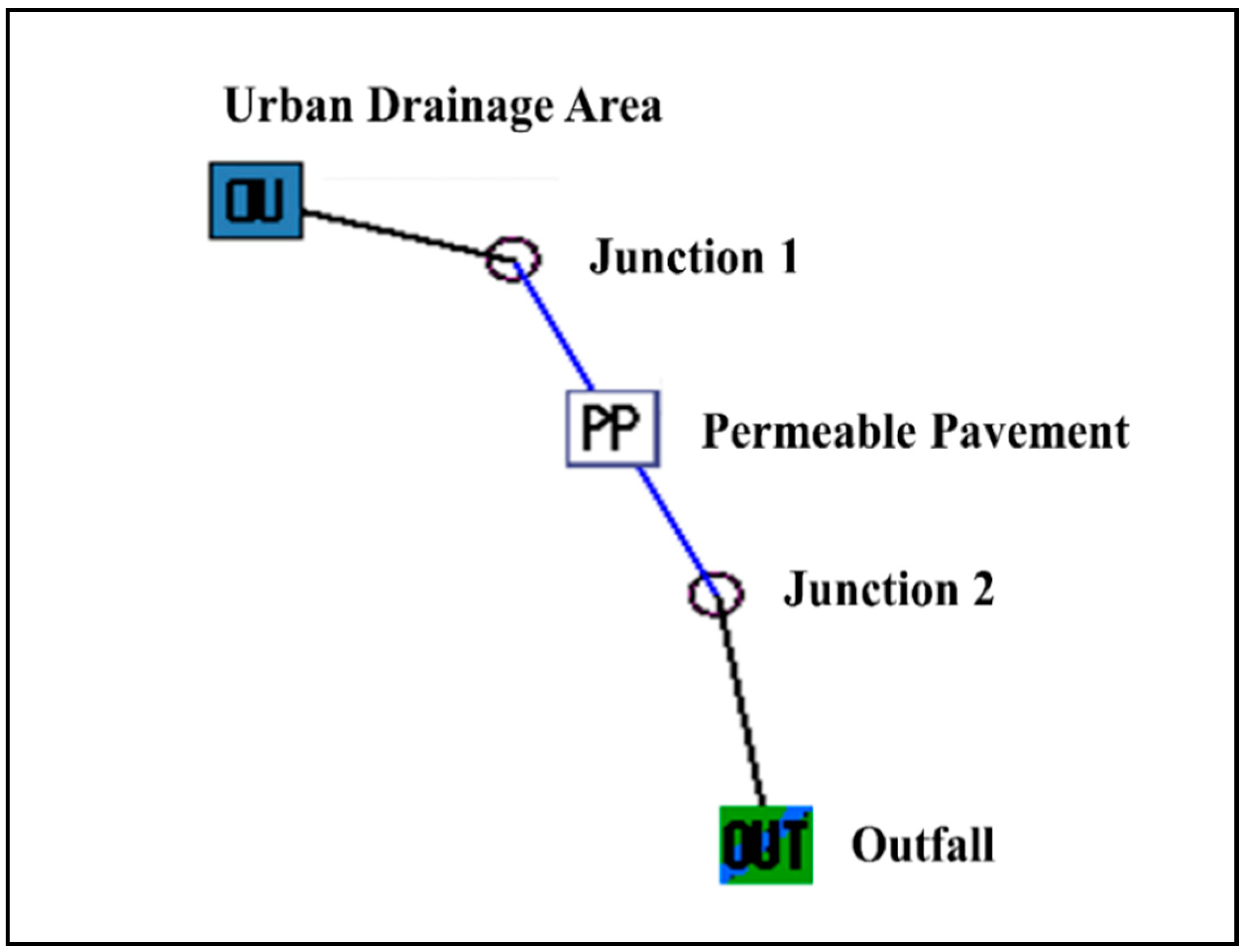

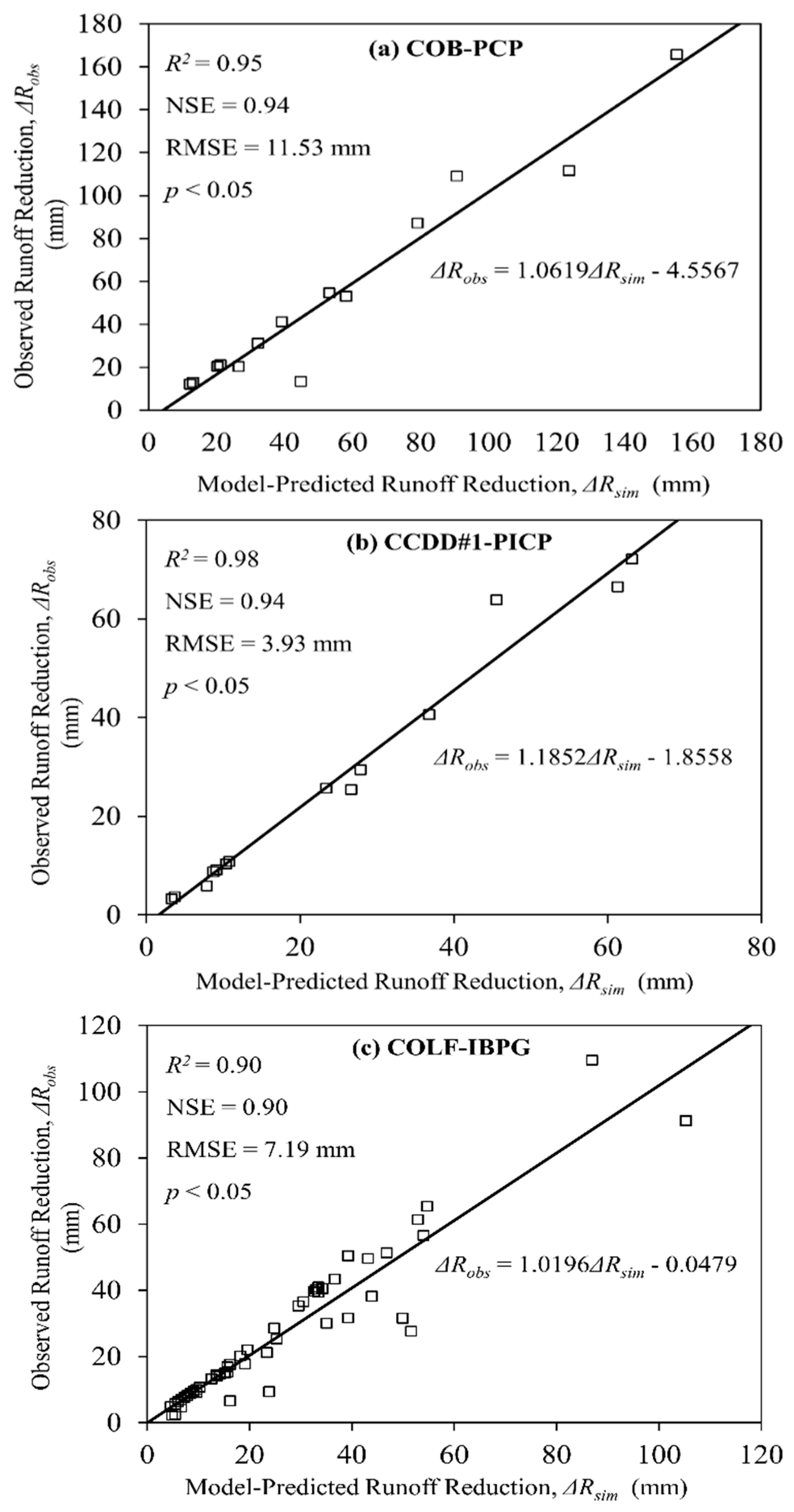
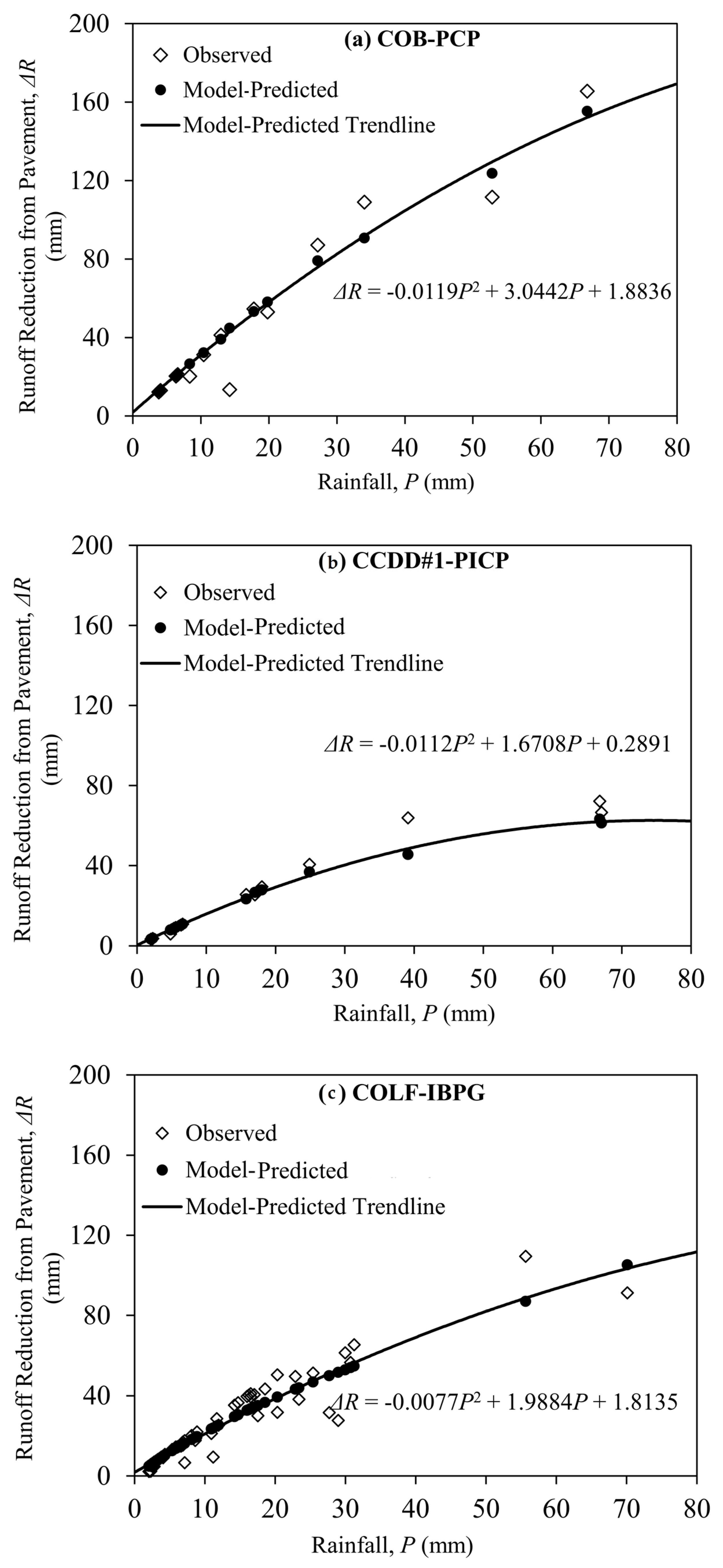
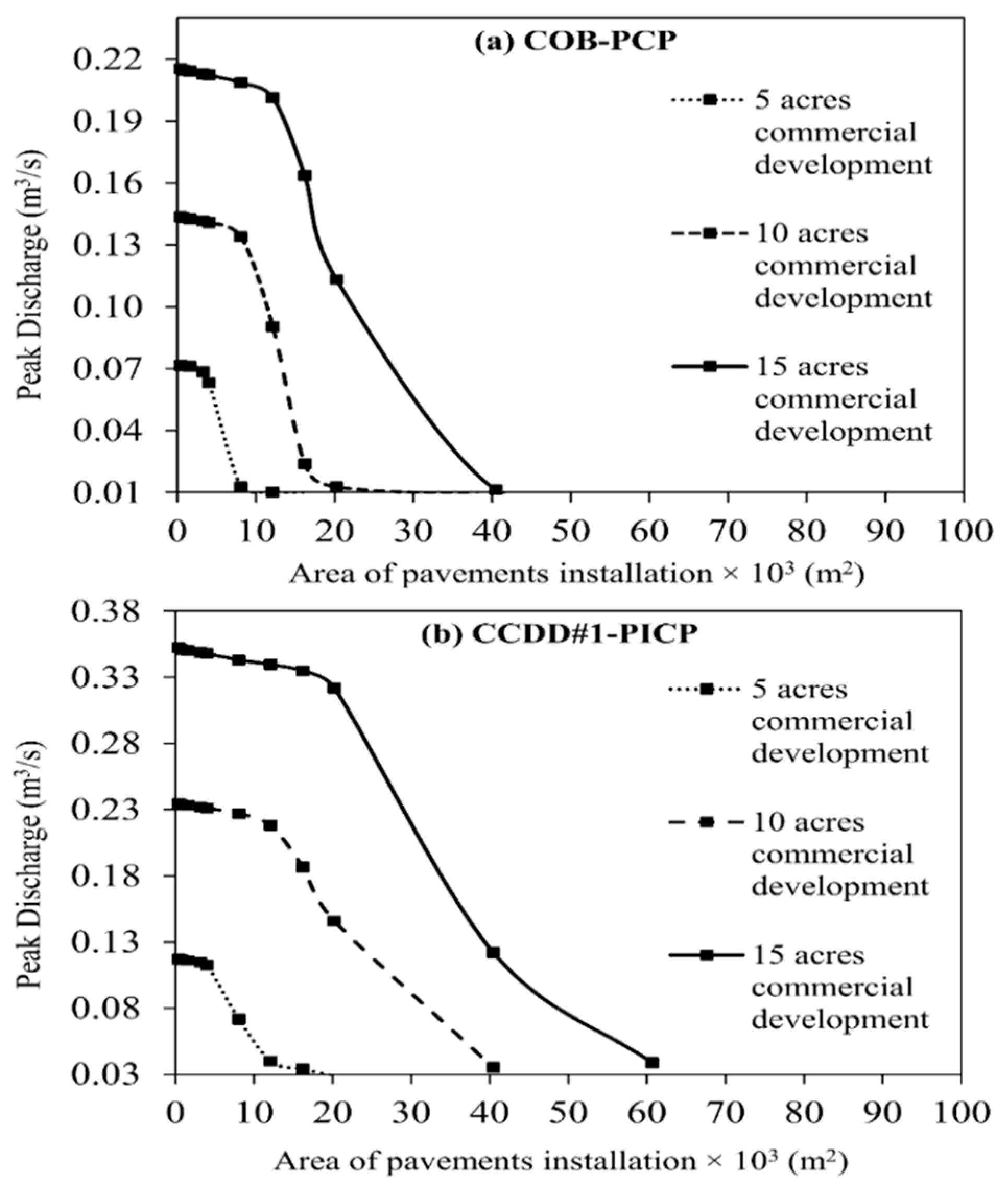
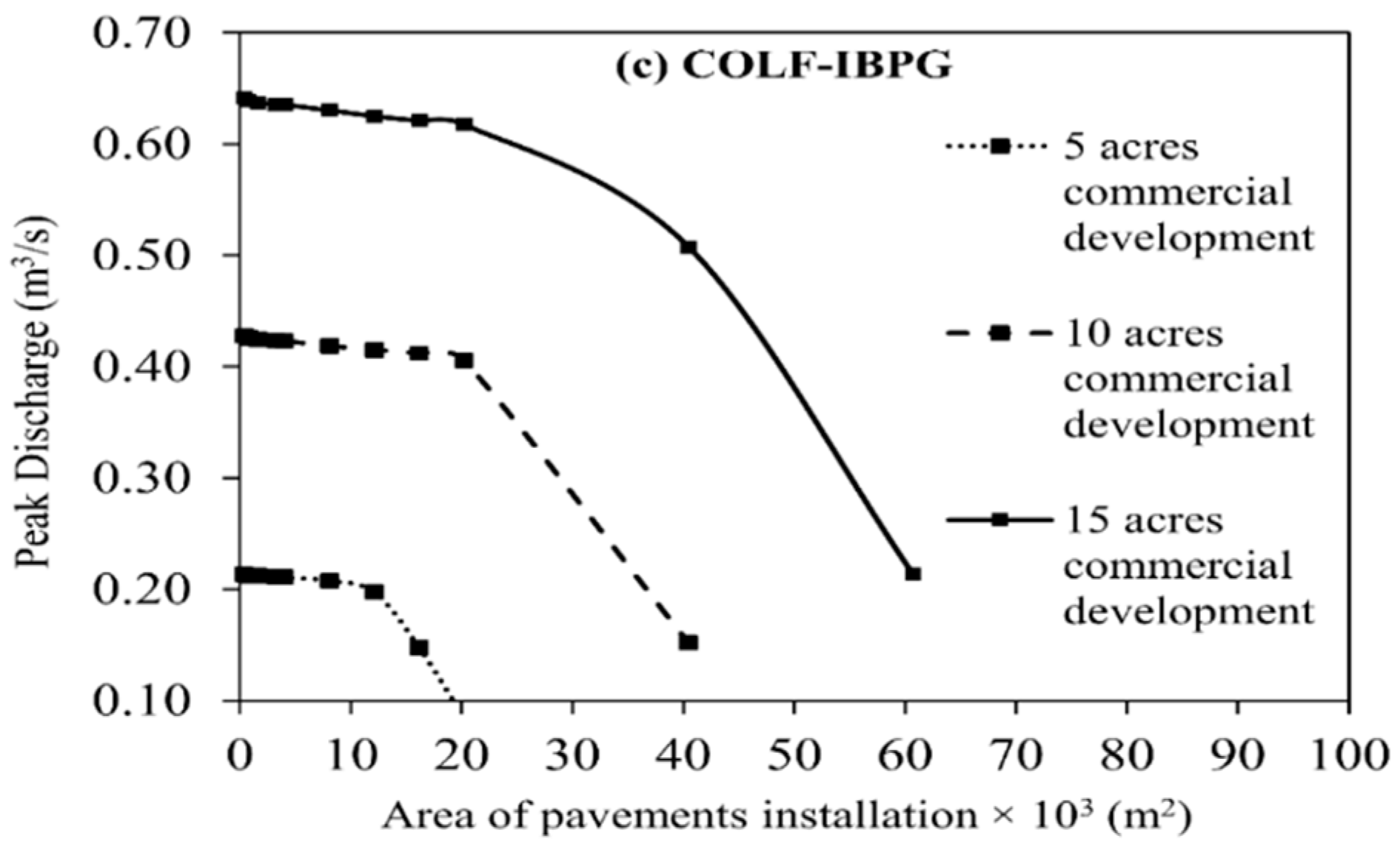
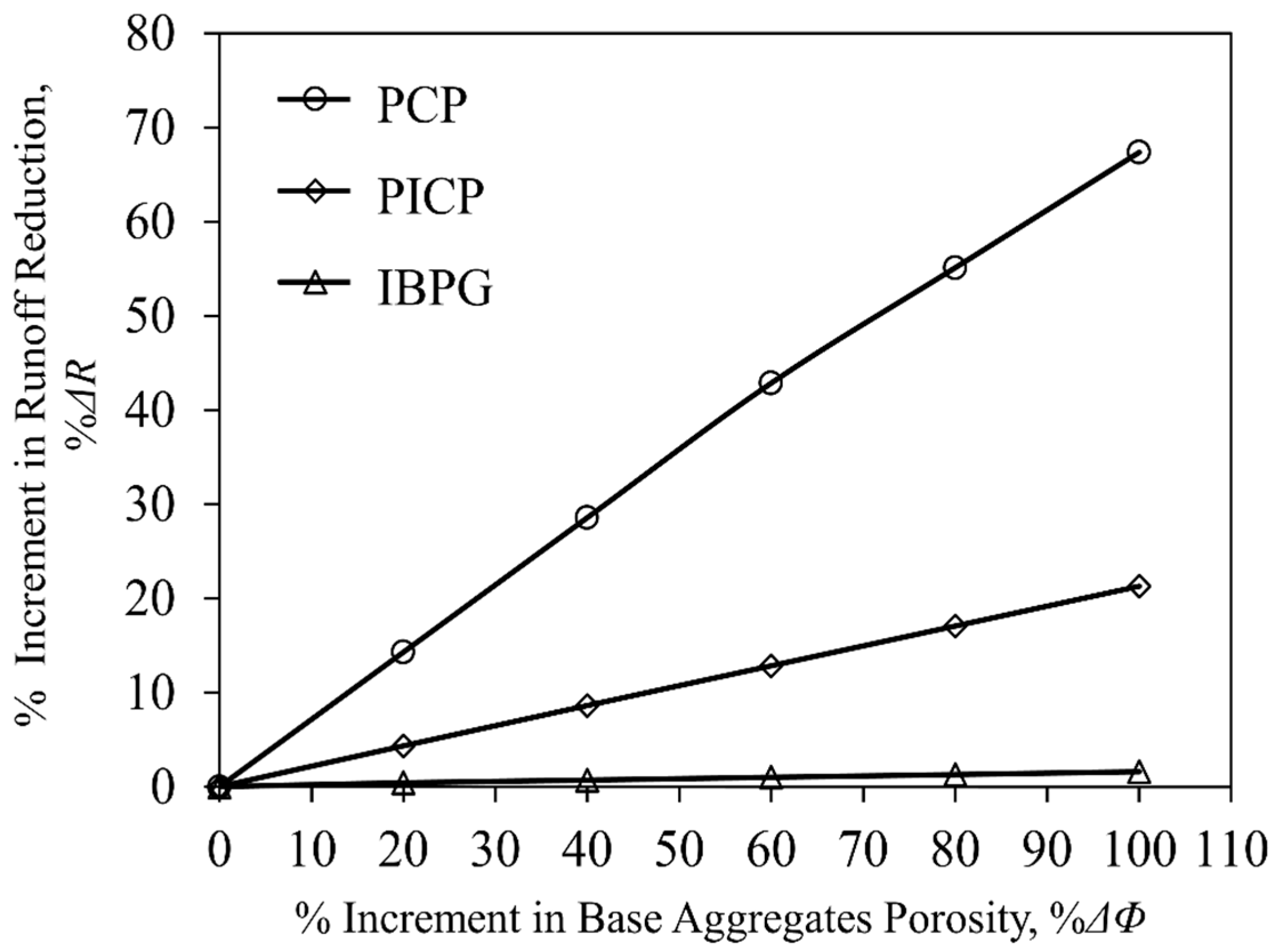
| Site ID | Drainage Sources | Area (m2) | No. of Flow Monitoring Events | Monitoring Period |
|---|---|---|---|---|
| COB-PCP | Pavement Section | 37.16 | 14 | September 2014–November 2014 |
| Impervious Cover (driveway, concrete trail, etc.) | 52.61 | |||
| Total Drainage Area | 89.77 | |||
| CCDD#1-PICP | Pavement Section | 372.31 | 14 | August 2014–February 2015 |
| Impervious Cover (driveway, concrete trail, etc.) | 246.86 | |||
| Total Drainage Area | 619.17 | |||
| COLF-IBPG | Pavement Section | 210.33 | 56 | May 2015–March 2016 |
| Impervious Cover (concrete sidewalk) | 40.47 | |||
| Large Landscape | 538.23 | |||
| Total Drainage Area | 789.03 |
| Parameters | COB-PCP | COLF-IBPG | CCDD#1-PICP | Source |
|---|---|---|---|---|
| Porous Pavement Area (acres) | 0.009 | 0.052 | 0.092 | Field-Measured |
| Pavement Surface Thickness (inch) | 3.0 | 3.0 | 3.0 | Design Sheet |
| Pavement Surface Porosity | 0.20 | 0.25 | 0.35 | Lab-Measured |
| Aggregate Bedding Thickness (inch) | 6.0 | 1.0 | 2.0 | Design Sheet |
| Aggregate Bedding Porosity | 0.35 | 0.40 | 0.38 | Lab-Measured |
| Aggregate Base Reservoir (base + sub-base) Thickness (inch) | 9.0 | 18 | 10.0 | Design Sheet |
| Aggregate Base Reservoir Porosity | 0.35 | 0.35 | 0.35 | Lab-Measured |
| Pavement Area to Aggregate Base Area Ratio | 1.00 | 1.00 | 1.00 | Calculated |
| Perforated Pipe Underdrain Diameter (inch) | 4.0 | 0 | 8.0 | Design Sheet |
| Pipe Underdrain Invert Elevation (inch) | 0.5 | 0 | 0.5 | Design Sheet |
| No. of Underdrain Pipes | 1 | 0 | 1 | Design Sheet |
| Subgrade Seepage Rate (inch/h) | 0.05 | 0.05 | 0.05 | Geotechnical Report |
| Initial/max Surface Infiltration Rate (inch/h) | 2000 | 900 | 900 | Field-Measured |
| Rainfall (mm) | COB-PCP 1 | CCDD#1-PICP 2 | COLF-IBPG 3 | ||
|---|---|---|---|---|---|
| Initial | Initial | Adjusted | Initial | Adjusted | |
| 1 | 0.000 | 0.000 | 0.000 | 0.000 | 0.000 |
| 2 | 0.000 | 0.000 | 0.000 | 0.000 | 0.000 |
| 3 | 0.000 | 0.000 | 0.000 | 0.000 | 0.000 |
| 5 | 0.000 | 0.000 | 0.000 | 0.000 | 0.000 |
| 10 | 0.023 | 0.023 | 0.000 | 0.005 | 0.078 |
| 15 | 0.038 | 0.038 | 0.013 | 0.007 | 0.109 |
| 20 | 0.058 | 0.058 | 0.021 | 0.010 | 0.155 |
| 25 | 0.069 | 0.069 | 0.032 | 0.012 | 0.186 |
| 30 | 0.076 | 0.076 | 0.038 | 0.014 | 0.217 |
| 40 | 0.120 | 0.120 | 0.042 | 0.016 | 0.248 |
| 50 | 0.200 | 0.200 | 0.066 | 0.018 | 0.279 |
| 60 | 0.200 | 0.200 | 0.110 | 0.019 | 0.295 |
| 70 | 0.200 | 0.200 | 0.110 | 0.020 | 0.310 |
| 80 | 0.200 | 0.200 | 0.110 | 0.021 | 0.326 |
| 90 | 0.200 | 0.200 | 0.110 | 0.022 | 0.341 |
| 100 | 0.250 | 0.250 | 0.138 | 0.023 | 0.357 |
| 125 | 0.300 | 0.300 | 0.165 | 0.024 | 0.372 |
| Site ID | Events | Rainfall Depth (mm) | Observed Runoff Reduction (mm) | Model-Predicted Runoff Reduction (mm) | %Error | Comments |
|---|---|---|---|---|---|---|
| COB-PCP | 11/11/2014 | 2 | 6 | 7 | 14 | Over-Predicting |
| 9/27/2014 | 21 | 50 | 61 | 18 | Over-Predicting | |
| CCDD#1-PICP | 8/13/2014 | 2 | 4 | 4 | 0 | Under-Predicting |
| 3/9/2015 | 4 | 6 | 6 | 0 | Over-Predicting | |
| 12/9/2014 | 19 | 32 | 28 | 14 | Under-Predicting | |
| 9/3/2014 | 55 | 64 | 58 | 10 | Under-Predicting | |
| COLF-IBPG | 9/13/2015 | 3 | 6 | 7 | 14 | Over-Predicting |
| 1/3/2016 | 10 | 21 | 22 | 5 | Over-Predicting | |
| 4/24/2016 | 17 | 27 | 33 | 18 | Over-Predicting | |
| 2/3/2015 | 18 | 43 | 34 | 26 | Under-Predicting | |
| 1/2/2016 | 20 | 35 | 38 | 8 | Over-Predicting | |
| 4/4/2015 | 21 | 52 | 40 | 30 | Under-Predicting |
| Size of Commercial Development (acres) | 50 Years-24 h Post-Development Peak Discharge (m3/s) | 10 Years–24 h Pre-Development Peak Discharge (m3/s) | Required PCP Installation Area (m2) 1 | Required PICP Installation Area (m2) 2 | Required IBPG Installation Area (m2) 3 |
|---|---|---|---|---|---|
| 5 | 0.21 | 0.037 | < 8000 | <14,000 | >20,000 |
| 10 | 0.43 | 0.074 | <16,000 | <35,000 | >40,000 |
| 15 | 0.64 | 0.110 | <21,000 | <47,000 | >60,000 |
© 2019 by the authors. Licensee MDPI, Basel, Switzerland. This article is an open access article distributed under the terms and conditions of the Creative Commons Attribution (CC BY) license (http://creativecommons.org/licenses/by/4.0/).
Share and Cite
Alam, T.; Mahmoud, A.; Jones, K.D.; Bezares-Cruz, J.C.; Guerrero, J. WinSLAMM Simulation of Hydrologic Performance of Permeable Pavements—A Case Study in the Semi-Arid Lower Rio Grande Valley of South Texas, United States. Water 2019, 11, 1865. https://doi.org/10.3390/w11091865
Alam T, Mahmoud A, Jones KD, Bezares-Cruz JC, Guerrero J. WinSLAMM Simulation of Hydrologic Performance of Permeable Pavements—A Case Study in the Semi-Arid Lower Rio Grande Valley of South Texas, United States. Water. 2019; 11(9):1865. https://doi.org/10.3390/w11091865
Chicago/Turabian StyleAlam, Taufiqul, Ahmed Mahmoud, Kim D. Jones, Juan César Bezares-Cruz, and Javier Guerrero. 2019. "WinSLAMM Simulation of Hydrologic Performance of Permeable Pavements—A Case Study in the Semi-Arid Lower Rio Grande Valley of South Texas, United States" Water 11, no. 9: 1865. https://doi.org/10.3390/w11091865
APA StyleAlam, T., Mahmoud, A., Jones, K. D., Bezares-Cruz, J. C., & Guerrero, J. (2019). WinSLAMM Simulation of Hydrologic Performance of Permeable Pavements—A Case Study in the Semi-Arid Lower Rio Grande Valley of South Texas, United States. Water, 11(9), 1865. https://doi.org/10.3390/w11091865




